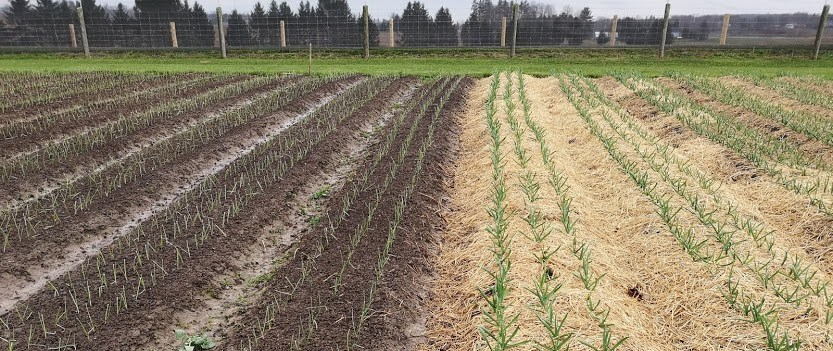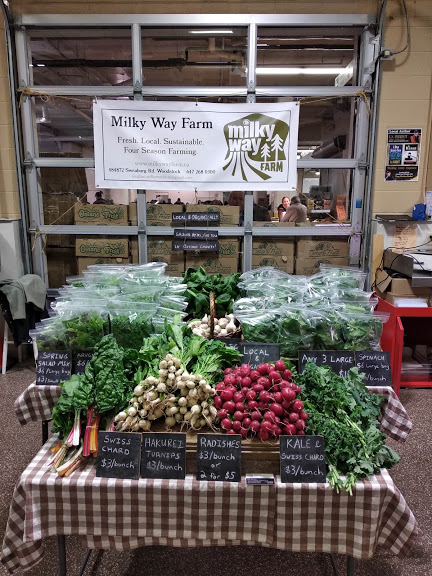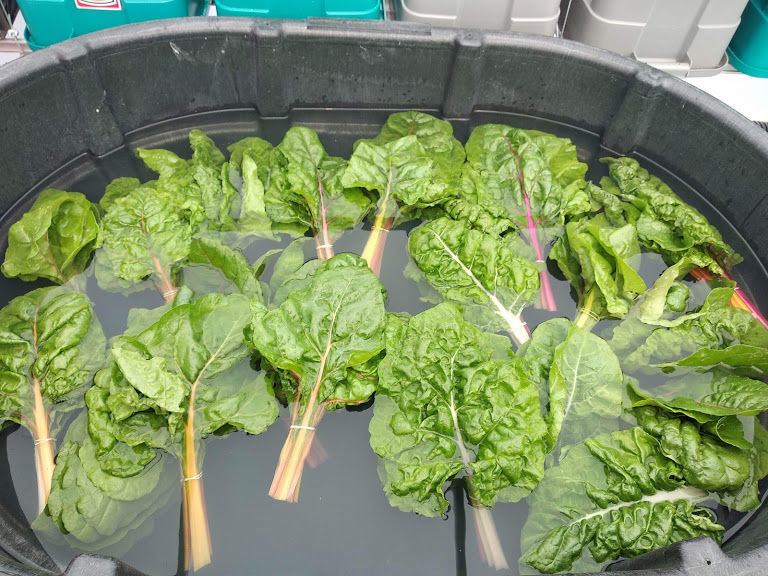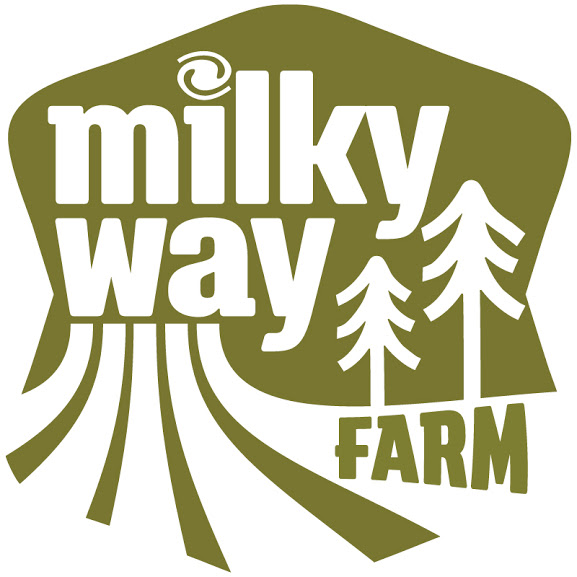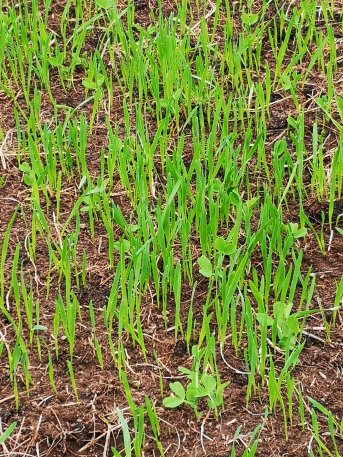
Milky Way Farm
Fresh. Local. Sustainable. Four Season Farming.
Posted on February 1, 2023 by milkywayfarmca
Posted on February 1, 2023 by milkywayfarmca
Posted on August 25, 2022 by milkywayfarmca
Posted on February 12, 2021 by milkywayfarmca
Posted on March 25, 2020 by milkywayfarmca
Posted on February 21, 2020 by milkywayfarmca
Posted on February 21, 2020 by milkywayfarmca
The weeks have been flying by for us this spring, as is typical for any market farmer. A new farm, a new baby, and a new heated greenhouse have ensured that we have been on a pretty steep learning curve this year. Add to that increasingly unpredictable spring weather, and it would be enough to drive many away from the seemingly ideal world of small-scale diversified market farming. But we have committed ourselves to this worthwhile cause, and trudge on we must–even if these April snows keep falling.
Another rainy week does allow for a few of the things to happen that would normally be pushed to the bottom of the to-do list at this time of the year. One of these things of course is a newsletter, so here we are.
Planting continues in the greenhouse, as early zucchini, cucumber and eggplant are ready to be transplanted into the 3 remaining greenhouse beds, to join the tomatoes and peppers that have been planted out for the past month, and are growing steadily. Successions of seedlings are started every week to be eventually planted out in the field, as soon as the rain stops long enough to let us to work the soil again. While we have been focused on early season crops like lettuce, kale, and green onions for a while, my planting schedule is telling me that we have now approached melon starting season! Every year this signifies to me a shift in focus towards all of the summer crops that will start filling the fields as soon as the weather starts to settle, and an indication that things are about to get even busier!
We have managed to get a few of the early season field plantings underway, thanks to all of those early beds we prepped last summer/fall, and covered with silage tarp to keep off the winter rain. Salad mix greens, spinach, lettuce, radish, turnip, snap peas, chard, beets, kale and kohlrabi have been planted out, and have thus far been weathering all of the storms we have had lately. Another big planting task we have completed is the storage onions, which get planted once per season are really enjoying all of this rain we have had lately. These also got in nice and early thanks to our prepared beds, and have not been drowning due to the beds being raised a few inches above the path level.

The garlic that we planted last October is up a bit later than usual, but is looking great! 
Successions of lettuce are planted every few weeks throughout the year, to ensure constant supply. 
The storage onions were planted in beds that we prepared last year, to make sure we could get them in early, despite the weather. 
Field sown arugula has sprouted, and will me ready for market in about 3 weeks.
We have been really enjoying spending all of this cold, rainy, spring weather safely protected in our new heated greenhouse, and I have to say I feel a bit of a disconnect this year from the true season, as it has felt like late spring/early summer to us for over a month now.
Our seedlings are also really enjoying the mild climate and diffuse natural light provided by the plastic structure, and the promise of ripe tomatoes in May is very encouraging. But greenhouses do have their downsides, as we have discovered all too soon. Besides the soaring propane bills that almost keep us up at night wondering if the tomatoes and peppers really need to be “that” warm to thrive, is the almost immediate onslaught of insect pests that seem to appear overnight in numbers that can no longer be controlled by finger squishing patrols.
For us this year, it is aphids. They quickly got out of control, and began to multiply and spread throughout the greenhouse, attempting to devour everything in sight. Thankfully our tomatoes and peppers were big and healthy, and have so far withstood the feeding pressure, but our earliest try at cucumbers did not fare so well. We have since released ladybugs by the thousand, along with some beneficial wasps and generalist predators to take care of the aphids for us, but time will tell what kind of long term damage they may have done to some of our seedlings. I feel like any new greenhouse owner should be given a welcome package of beneficial insects and host plants, to start them off in the right direction.

The tomatoes are now nearly 5′ tall, and setting multiple fruit clusters per plant. 
The eggplant have recovered from some early aphid damage, and are almost ready to plant out into the remaining greenhouse beds. 
It wont be too long before these beefsteak tomatoes make their way to your dinner table! First dibs go to CSA members, so don’t forget to sign up.
CSA SIGN-UP NOW OPEN!
We are now accepting sign-ups for the Summer 2019 season of our weekly veggie box program. Joining a CSA (Community Supported Agriculture) program helps us farmers make sure the veggies we grow this season will find a good home (hopefully on your dinner table!), and also helps us cover all of our early season costs associated with producing these veggies.
We offer two different “share” sizes, a full share designed to feed a family of four, and a small share, to feed a family of two, and offer full choice over what goes into your share each week. Members will come to the farm to pick up their shares Tuesdays between 4-8pm, and will choose 15 veggies (full share) or 8 veggies (small share) from our display tables. Payment is due at the start of the CSA season, but as a benefit members will receive a discount above retail prices found at the market.
Besides all of the seeding, transplanting, bed prep, tomato trellising, watering, weeding, and tarp moving we have been doing in the last month or so, we have also been busy harvesting, washing and selling our early season goodies at the downtown Kitchener Farmers Market for the past 7 Saturdays, and Jesse will be there every week from now on to hook you up with all of your local veggie needs until our CSA program starts in June. So far this spring we have garlic (last years crop), loads of big juicy spinach, kale, chard, arugula, salad mix, radish and baby turnip, with lots more variety on the way in the next few weeks. Stop by and see us every Saturday, 7am to 2pm inside the main market building.
Want to keep up with all of the changes happening here on the farm? Join our newsletter mailing list here:
Posted on April 29, 2019 by milkywayfarmca
Spring weather doesn’t seem to be quite on its way, but we have been busy this past month getting our heat and hot water working in the new greenhouse, and starting the first of our spring and summer crops which will make their way to market, and fill out CSA veggie boxes.
Even though this past February has been a particularly cold one, we have been spending most of our days with our hands already in the soil, preparing our greenhouse growing beds, and setting up our new propagation area, where we will grow most of our transplants once we raise the temperature a bit more.
We installed PEX tubing at a depth of 8 inches below the soil in our growing beds, which are circulating hot water using a tankless water heater as a way to heat the soil and supply heat right where the plants need it, at their roots, instead of heating the entire greenhouse air space through the winter. This supplemental hydronic heat should also allow us to plant out tomatoes and peppers a bit earlier without shocking the plants with cold soil. We will still heat the greenhouse air once the tomatoes and peppers are planted out, but we should be able to lower the temperature a bit, and hopefully save on propane costs.
We are also using this heated water function to create a heated bench for our tomato and pepper seedlings as they grow by running the PEX tubing on top of an insulated table.

We built a sturdy frame out of 2×4 and 2×6 lumber, and topped it with 1″ insulation board
We snaked PEX tubing back and forth across the table to distribute the hot water heat.
Crates of potted peppers and tomatoes sit on top of the table and are heated from the hot water tubing lines below.
We cover the plants with a layer of row cover and plastic for night, creating a greenhouse within a greenhouse effect.
Our basement light racks are still filling up with newly sprouted trays of seeds, including perennial herbs and beneficial insect attracting flowers which will eventually make their way into our perennial orchard strips. And this upcoming week we will be making a big seeding push as many of our early brassicas like cabbage, kale, broccoli, cauliflower, kohlrabi, as well as Swiss chard and beet will be started in our seedling germination chamber. These will be grown out under lights on racks for a few weeks before making their way to the greenhouse propagation area to continue a few more weeks of growth, waiting for the snow to melt and for spring to officially arrive.

Onions were the first seeds we planted this year, and are hardy enough to grow in the main greenhouse area, which we keep heated to 4 degrees C.
CSA SIGN-UP NOW OPEN!
We are now accepting sign-ups for the Summer 2019 season of our weekly veggie box program. Joining a CSA (Community Supported Agriculture) program helps us farmers make sure the veggies we grow this season will find a good home (hopefully on your dinner table!), and also helps us cover all of our early season costs associated with producing these veggies.
We offer two different “share” sizes, a full share designed to feed a family of four, and a small share, to feed a family of two, and offer full choice over what goes into your share each week. Members will come to the farm to pick up their shares Tuesdays between 4-8pm, and will choose 15 veggies (full share) or 8 veggies (small share) from our display tables. Payment is due at the start of the CSA season, but as a benefit members will receive a discount above retail prices found at the market.

Our Summer CSA weekly veggie box program starts June 11th, and runs for 18 weeks.

An example of a mid-late summer Full Share CSA box
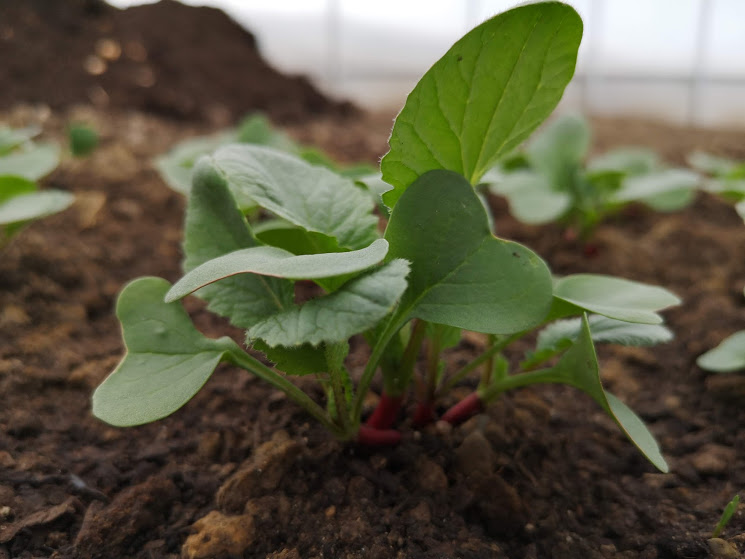
All Summer CSA veggies are harvested fresh the day of pick-up, ensuring you are getting veggies at the peak of their flavour and nutritional value.
We have been seeding and transplanting into the beds we have prepped in the greenhouse in anticipation of attending the Kitchener Farmer’s Market in a few weeks. We will be bringing our over-wintered spinach, and hopefully some radishes and salad turnips, with lettuce mix and other salad greens following in the weeks to come. Come and see us inside the main market building at 300 King St. E in downtown Kitchener if you live in the area.
Want to keep up with all of the changes happening here on the farm? Join our newsletter mailing list here:
Posted on March 4, 2019 by milkywayfarmca
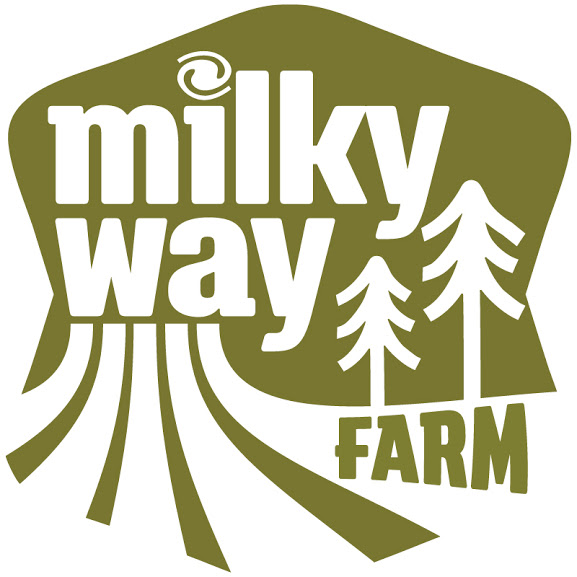
It is the start of a new year, and we have experienced some major changes here on the farm!
Most notable is the arrival of our first born, Harry, entering our lives on November 15th of 2018. We have been very much enjoying the somewhat quieter winter scene getting to know each other, and adapting to our new normal. But of course, life on the farm continues, and Harry has already had a taste of things to come, helping Meghan weed the winter spinach in the hoophouse.

Meghan and Harry giving the winter spinach a quick once over in the unheated hoophouse. 
Jesse, Meghan and Harry out for their first family stroll through the new heated greenhouse.
And of course, another huge improvement to our farm is the (near) completion of our large heated greenhouse!! This cathedral will provide fresh tender greens and salad crops all winter, grow our seedlings and transplants in the spring, and will be a safe place to get a head start on our summer trellised crops of tomato, pepper and cucumber. We are still working at getting the heating sources installed, and look forward to spending some sunny afternoons out of the cold wind, getting the soil into growing shape ahead of this year’s crops.

We have also planted the first of our fruit trees and shrubs into what will become our perennial orchard strips. We will plant these 12′ wide windrows with mixed fruiting trees and shrubs, perennial herbs and flowers, bioaccumulators, and beneficial insect attracting companion plants in order to establish biodiverse windbreak strips, all mulched with wood chips. We hope these orchard strips will eventually flourish, and provide habitat and food sources for all of the various pollinating species, as well as insects beneficial to protecting our vegetable crops. The perennial root systems, wood chip mulch and undisturbed soil will act as a mycorrhizal fungi reserve, further supporting the health and success of our neighbouring annual vegetable crops.

The snow came a bit earlier than anticipated, but family pitched in to help get the first orchard trees and bushes tucked in safely. 
We mulched the surrounding area with a thick layer of wood chips to keep weeds down, retain moisture, and encourage soil mycorrhizal fungi populations.
We also received our brand new logo (featured at the top of the page) courtesy of the very talented Amanda DeVries (http://www.amandadevries.com), and are excited about having our own visual identity to distinguish us at the market. We hope this symbol will become familiar to you in the future as we grow!
Want to keep up with all of the changes happening here on the farm? Join our newsletter mailing list here: http://eepurl.com/dhTf1z
Posted on January 14, 2019 by milkywayfarmca
Seed starting, greenhouse preparations, raised beds.
It is officially fall here on the farm, but seed starting and planting are just ramping up for us this year. The first seeds to germinate in the field were a cover cop of oats and winter peas. We planted these into a few of the field blocks we had tarped, and then worked with the rotary plow, having added some composted manure in order to give the cover crop enough fertility to get a good start on growth. This combo of oats and peas will not survive through the winter, but will die back once the weather really turns, leaving a mulch of plant residue to protect the soil from the water and wind erosion that happens to bare soil over winter. By spring the mulch will be mostly decomposed, and the field ready to be worked for spring cops, adding a bit of organic matter to the soil.
We are also currently filling our basement with seedlings destined for our future greenhouse. It will still be a few weeks before the structure itself goes up, but we are starting some cool season greens like lettuce, and kale, and green onions ahead of time so they can be transplanted into the greenhouse beds as soon as the structure is complete. We are also doing a trial of overwintering onions, which will be transplanted outside into raised beds in a few weeks.

Mixed lettuce growing steady under LED lights in the basement, with onion seedlings in the background.
The greenhouse we are building is an integral part of our plan to provide local vegetables year round to our community, and is also a fairly large investment for our first year in operation here on Sweaburg Rd. We are quickly coming to the end of the planning phase, and all of the elements are starting to come together to make this project a reality.
Just this week we had a larger diameter water line installed, and brought to the greenhouse location, so we will have year-round water access, and we have also been working hard at grading and levelling the site to reduce some of the slope that exists pretty much everywhere on our farm.
This greenhouse will be minimally heated through the winter using a hydronic radiant heating system to warm the growing beds directly via hot water sent through PEX pipe buried in the soil. We hope to minimize the energy and fuel needed to keep our more tender winter greens alive by only heating their immediate surroundings instead of the entire greenhouse structure.
We have big plans, but there is quite alot to do to make our plan happen before winter sets in.

Probably not so exciting to non-farmers, but this frost free hydrant will allow us year round water access in our greenhouse.

Jesse got to star in his own episode of “Mighty Machines” last weekend, using a rented excavator to dig up topsoil from a future pond site to add to the greenhouse base.

The back end of the future greenhouse site slopes a bit too much so we had to move quite a bit of soil to raise it up.
We are continuing to plug away at setting up our infrastructure, and are very excited about all of the very big things happening in the next few months!
Want to keep up with all of the changes happening here on the farm? Join our newsletter mailing list here: http://eepurl.com/dhTf1z
43.072762
-80.747789
-80.747789
Posted on September 30, 2018 by milkywayfarmca
Milky Way Farm








